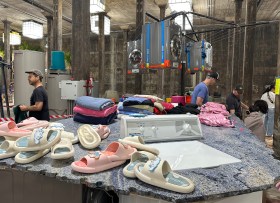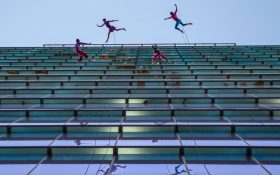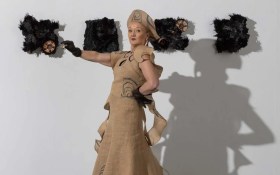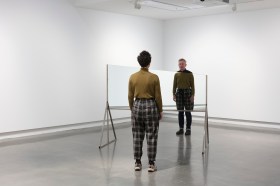There are landscape paintings aplenty on the Gold Coast. The endless horizon offered by the ocean. The rugged yet lush hinterland. In the centre, an incandescent cosmopolitan vista. Each has provided inspiration to professional artists and dabbling hobbyists alike. They set the stage for A Bigger View, a unique exhibition of landscape paintings, combining artworks drawn from the collections of Home of The Arts (HOTA) and the National Gallery of Australia (NGA).
Of the seven artists, local William Robinson holds a candle to a First Nations legend from Far North Queensland, two British superstars of their time, a prominent New South Welshman and the Austrian migrant who inspired him. The artwork by the latter, is North-east view from the Northern Tip of Mount Kosciusko (1863). Its maker was Eugene von Guérard, a pioneer of the Melbourne art scene and a painter drawn to Victoria by the 1850s gold rush.
The painting is a dramatic recount of Guérard’s visit to the region a year earlier, as part of an expedition led by scientist Georg von Neumayer. In content and construction, the painting exemplifies principles of the Düsseldorf school. There is a neoclassical precision to his application of linear perspective. The topography is purportedly accurate. In the foreground, however, elements, like the rocks, have been added. Equally romantic are the mannerisms exhibited by his figures. As in many a frontier painting from the 19th century, they are diminutively depicted, to convey the grandeur of the land settled.
Pairing it with Mountain Analogue (1985) by Imants Tillers, which was inspired by the former, could be considered a master stroke. This timely appropriation of the oil on canvas reflects significant technological and cultural development over the intervening century. It’s been enlarged using synthetic polymer paint and oil sticks. The gestural marks, which span the 165 slightly mismatched canvas boards, could be compared to pixels.
While referencing a book by René Daumal in its title, ‘analogue’ could aptly describe a distinct difference in processes. Whereas Guérard’s work was painted during the nascence of photography, Tillers’ was rendered at the commencement of the digital age. The depictions of von Neumayer’s team of scientists are more easily spotted at this scale. A dismantling of the Australian cultural landscape may also be read in this post-modern reinterpretation by a Sydney-born son of Latvian émigrés.
Adjacent to Mountain Analogue hangs another monumental artwork, which appears to have inspired the name of this exhibition, A Bigger Grand Canyon (1998). David Hockney, the British artist who sojourned in California, committed over a decade and a half to the task of conveying its magnitude and majesty. The painting spans 60 canvases, with its picture planes being initially photographed. In this post-digital era, there is a poignancy about his methodical surveying of the space and then meticulous rendering of its surrogate. The colourful cubist composition is compelling. On the one hand, shared is a compulsion of an artist to look at scenery. On the other, offered is the opportunity to gaze upon an internal landscape.
Hung on the opposite wall are two paintings by Hockney’s contemporary, Bridget Riley. An avant-garde artist of the Op Art movement in Western Europe and North America, her preoccupation appears to be the experience of seeing. She named Post-Impressionist Georges Seurat among her influences. She’s also made mention of ‘colour being faceted‘ by water. However, the hypnotic waves of flat synthetic polymer paint in Reef (1976) are unlikely to be a mimetic representation. Her dynamic compositions of colourful yet constrained forms are in and of themselves evocative.
Comparatively unbridled in its brushwork is Nyinylki (2010) by Mirdidingkingathi Juwarnda Sally Gabori (Kaiadilt people). Her memories of an outstation on Bentinck Island, from which she and her family were removed in 1948, are expounded with exuberance. Understanding little English, she was introduced to painting at a Mornington Island cultural centre at the age of 81. Perhaps as a consequence, Gabori was unhindered by existing painting rhetoric. Elements from the landscape of her youth are resplendently represented. The juxtaposed layering of cobalt and ultramarine seems to suggest an abundance of both fresh and salt waters. It isn’t difficult to understand her meteoritic rise and continue salience.
Having traversed two centuries of evolution in the Australian cultural landscape, we arrive back at William Robinson’s Springbrook Dawn (1999). This inclusion is relatively understated for the artist, who is renowned for his panoramic paintings of the Gold Coast Hinterland. Comfort is offered through the familiarity of his hand and subject matter.
Read: Exhibition review: Bruce Reynolds and Hiroe and Cornel Swen, Canberra Museum and Gallery
The remainder of the exhibition, however, could be arousing, if not unsettling, for some visitors. Chronicled through this tight set of paintings are periods of settlement, diversification and international exchange. The emergence of a national identity based on reconciliation, may be considered the crescendo. Once entering, it’s impossible to look away – literally.
A Bigger View will be on display at HOTA until 21 June 2026; free





